#Hezbollah hideouts
Explore tagged Tumblr posts
Text
1990 के बाद इजरायल ने किया सबसे बड़ा हमला, हिजबुल्लाह के 1200 ठिकाने तबाह; 492 लोगों की मौत
1990 के बाद इजरायल ने किया सबसे बड़ा हमला, हिजबुल्लाह के 1200 ठिकाने तबाह; 492 लोगों की मौत #News #BreakingNews #ViralNews #Update #Trending #Info #HindiNews #CurrentAffrairs #NewsUpdate #RightNewsIndia #RightNews
Israel Hijabulla War: इजराइल ने हिजबुल्लाह के खिलाफ विनाशकारी युद्ध छेड़ दिया है। इजराइल डिफेंस फोर्स (आईडीएफ) ने 1600 से ज्यादा हमले करके पूरे लेबनान को तबाह कर दिया है। दावा किया जा रहा है कि हवाई हमले में हिजबुल्लाह के 1200 से ज्यादा ठिकाने नष्ट हो गए हैं। 1990 के बाद लेबनान पर इजराइल का यह सबसे बड़ा हमला बताया जा रहा है, यानी 34 साल बाद लेबनान पर तबाही का नया कहर टूटा है। इस हमले में 492 से…
0 notes
Text
Hezbollah chief Hassan Nasrallah ‘suffocated in agony’ from toxic fumes inside bunker, Israeli report claims
An Israeli news outlet has claimed Hezbollah chief Hassan Nasrallah may have “suffocated” from toxic gasses inside his secret bunker after it was demolished by an Israeli airstrike.
Officials pulled Nasrallah out of the bunker on Sunday, finding his body intact with no visible wounds on him, Israel’s Channel 12 reported.
This suggested he was buried by rubble after 80 tons of bunker-busting bombs were dropped on his fortified hideout on Friday,
The Israeli outlet claims the cave-in caused the 64-year-old to suffocate and die in “agony” as the room filled with fumes from the smoke and explosions.

22 notes
·
View notes
Text
With fear and hunger their constant companions, the future promised only misery for the three Israeli hostages being held in a secret location in the heart of the Nuseirat refugee camp in the Gaza Strip.
Andrei Kozlov, Shlomi Ziv, and Almog Meir Jan were dozing on their mattresses on the floor of their darkened room on the Shabbos morning of June 8. After eight months in captivity, their captors had let down their guard somewhat — it was already mid-morning, and they were still sleeping in the next room.
Suddenly, the Israeli hostages heard shouting and gunfire. Instinctively, they tried to hide under their mattresses and blankets, in a vain attempt to shield themselves from the shrapnel. Then they heard a powerful explosion and a team of IDF soldiers burst into the house, led by the commander of the Yamam special forces unit, Arnon Zemora.
Zemora himself was struck by gunfire from the Hamas terrorists guarding the captives and mortally wounded, while additional Yamam soldiers burst in through the third-floor window. In one of the rooms, they found the three hostages — the gaunt, terrified captives cowering in the beams of the rescuers’ powerful flashlights, while the soldiers asked them to identify themselves by name.
“Andrei, Shlomi, Almog,” they answered, in turn.
“We’ve come to rescue you. Stay calm,” the soldiers told them.
Even so many months later, viewing the footage of the rescue is both scary and exhilarating. The elation of the rescuers and the disbelief of the hostages are both clearly evident, with the booming soundtrack of gunfire in the background. Like Yosef who was suddenly freed from Egyptian captivity, the captives went from chains to freedom within a few minutes.
But the viral footage was only the final, dramatic act of a story that played out over eight months. It’s a story of fortitude and miraculous survival, and of a lifesaving camaraderie forged in a shared horror whose enormity only the three protagonists can really comprehend.
Now, months after Andrei, Shlomi, and Almog have been freed from captivity, the news seems encouraging. Hamas has been flattened, Hezbollah has been dealt a serious blow, and Syria’s Assad is gone. But dozens of hostages are still captive in Gazan tunnels and squalid hideouts. As Israel and Hamas once again debate prisoner releases, for the first time, Shlomi and Almog share their story together. “We’re waiting for everyone to be released,” they say. “That’s our daily wish and prayer.”
Mutual Fate
Before Simchas Torah 5784, the three men were strangers to each other, never imagining that something would bind their fates together in an unbreakable bond.
Almog Meir Jan, 21, from Or Yehuda, had been discharged from the army several months before he was kidnapped. Andrei Kozlov, 27, came to Israel the previous year from St. Petersburg, Russia, and was working as a security officer. And Shlomi Ziv from Moshav Elkosh in the north, the oldest among them, celebrated his forty-first birthday in captivity.
“I’m not a man of publicity and photographs,” Shlomi tells Mishpacha. And it isn’t just a cliche; to date, although his family has spoken to the media, he hasn’t yet given a single other interview. “I’m doing this now it only because I know how important it is to document all this,” he adds.
Almog agrees, relating how, once he returned from Gaza, he couldn’t believe that there are those who deny the horrors the terrorist are committing. “I was there, I was part of it, so how can they deny it?” he asks.
October 7, 2023, found all three men at the Nova event on Kibbutz Re’im, with Shlomi and Andrei both there as security officers. Feeling responsible for the welfare of the others, Shomi initially remained at his post, only fleeing when the gunfire drew closer.
“I passed the parking lot, heading in the direction of Gaza,” he recalls. “At one point, I could no longer run, and I hid behind a small bush. Someone ran up behind me, screaming ‘A terrorist is coming!’ and I heard gunshots.”
When the terrorist saw Shlomi, he motioned for him to come toward him. “From the first minute, I realized he was going to abduct me. I knew my fate was sealed, but there was nothing I could do,” he says.
At the same time, the terrorist spotted Andrei Kozlov, another one of the security guards at the event. “The terrorist motioned for me to call him,” Shlomi relates. “Andrei didn’t even understand what was going on. He thought at first that it was one of our soldiers. Then the terrorist asked me if I know how to drive. He sat me at the wheel, Andrei sat next to me, and the terrorist directed us to Gaza, about five miles away.”
During the short drive, Shlomi racked his brain thinking how he could get away. But his realistic conclusion was that he had no chance against hundreds of armed terrorists.
Almog had come to the event with his good friend, Tomer Sirosta, whose murder Almog learned about only after his rescue.
As soon as the early-morning missile fire started, the two friends got into their car and began to speed away. But then they noticed the terrorists on the road, and realized their only recourse was to try and flee on foot. They separated, and Almog hid between the bushes with four other young people who had fled — Elkanah Bohbot, Bar Cooperstein, Evyatar David, and Guy Gilboa Dalal — all of whom have been held in captivity for over a year now.
“There was a huge influx of terrorists with Kalashnikovs, RPGs, and grenades all around,” Almog recalls. “I decided to come out from the bush with my hands raised. They put me on the van with more people, and I felt like I was some kind of doll, unable to do anything. It was the most humiliating feeling in the world.”
No Chance of Escape
At first, Almog and his four friends were held in a storage room in an apartment. He recounts what happened afterward. “They took me to a different room and wrapped me up in a sheet. I was sure they were going to throw me into a grave. Who else gets wrapped in a sheet if not for a dead person? ‘Don’t kill me!’ I pleaded with them.
“They just laughed at me, and then proceeded to push me into the trunk of a car, sat on me, and punched and kicked me. One of them knocked the butt of his gun on my head. They treated me like I was a soldier in the elite Sayeret Matkal unit, as if I had the state’s most closely guarded secrets and I was their greatest enemy.”
What the terrorists didn’t know, and what Almog certainly wasn’t going to tell them, was that he’d actually been one of the soldiers operating the Iron Dome throughout the Gaza Envelope area during his IDF service, which certainly would have been of great interest to them.
He was driven to the apartment where Shlomi and Andrei were being held, but the men, who were blindfolded for the first three days and bound hand and foot, didn’t even see each other. “They took off the blindfolds only when we went to the bathroom or while we ate,” they relate.
The fear was overwhelming. Still, while the men didn’t exchange a word, the knowledge that they weren’t alone gave them strength. Of course, it never entered their minds that they would be spending the next eight months together, or that they’d be transferred to six other apartments, meeting new terrorists and captors each time. Finally, they were taken to Nusseirat, where they spent six months, tied up, without once seeing the light of day, guarded by terrorists who read them chapters from the Koran and gave them no opportunity to escape.
After the first three days of captivity, their blindfolds were removed, but their hands and legs remained tied for about two and a half months. Almog remembers the date when they were released from the handcuffs — it was 5 Teves.
The constant bombardments also caused them terrible fear. Shlomi recounts a particularly terrifying day, when Israeli intelligence warned all Gaza residents to leave the area, as they were going to bomb it.
“Within four minutes, no one was left in the neighborhood. We heard the women and children fleeing. Even those in the house with us fled — including all our captors, save for one. We remained tied up, hearing the planes in the sky, with the terrorist guarding us with a knife in his hand.”
They did consider overpowering the terrorist and running away, “but we realized there was no point,” Shlomi relates, “because even if we’d manage to get outside, what would happen? They would see us outside with the chains and realize exactly who we were.”
Almog remembers that as a very low point. “We understood there was no chance of escaping,” he says.
Shlomi says their captors made sure they’d heard about the tragic story of the three hostages who escaped and were mistakenly shot by the IDF, disillusioning them of any fantasies of rescue.
“Our captors were very explicit — they told us that if the IDF would come to rescue us, they’d murder us on the spot. If the soldiers would manage to reach us, they’d be bringing home dead bodies.”
Dreaming of Freedom
It’s not easy for Shlomi and Almog to look back at the months they spent in captivity. They say the hardest part was the uncertainty — they never knew what their fate would be in five minutes’ time, who would be coming to guard them, if they’d be moved somewhere else, and what kind of plans their evil captors had in store for them.
One of the hardest times, they say, was after the first hostage release deal on November 22. There was intense missile fire and bombardments, and situated as they were so close to the center of it all, they heard gunfire all night long. “The explosions were very close, the whole building was shaking,” Shlomi says.
They also remember the hunger, and the food distribution that they’d arranged among themselves: One got a bit more pita and the other a bit more cheese, depending on each one’s preferences. If they were given four dates instead of three, they would discuss what to do with the fourth date and who should eat it. Sometimes, they also kept a bit on the side, knowing they couldn’t count on their next meal.
What kept them from falling apart was their feeling of certainty that one day they would leave Gaza. “We never stopped believing that we’d go home,” Almog stresses. “I imagined myself at home all the time, what I was doing, and where I would go visit.
“But there were also disappointments. Every time we heard there might be a deal, we thought, ‘Maybe this time we’ll be surprised,’ but time and again our hopes were dashed.
Almog says that while Entebbe was obviously on everyone’s mind, they hoped for a deal more than for a rescue, because they assumed it would give them a better chance of getting out alive.
“We understood that if there would be a rescue, the IDF would come close and there would be gunfire and explosions, and our captors would surely hear it and fight back. We didn’t want to get into that kind of situation. We didn’t want the soldiers to endanger themselves for us, and we didn’t want to be in any more danger either.”
Almog says they knew about the hostages who were released, which left them with mixed feelings. “We were happy for the hostages who were released, but we were also very worried that after they released the women and children, we’d be forgotten about. Every so often, we heard that there was talk about a new deal and that got our hopes up and gave us strength. But a week later, we were told, ‘There’s no deal.’ Again a disappointment.
“The captors enjoyed telling us over and over again that ‘they don’t want you in Israel, it’s not important to them to get you back alive.’ And they always added, ‘Netanyahu doesn’t want you.’ ”
In retrospect, Almog says he really doesn’t understand how they were able to listen to these harsh and depressing statements without reacting. “You learn to hear and be quiet, to be smart and not right,” he explains. “Only our faith kept us going, and it was very strong.”
“Sometimes there were moments when I thought to myself, Wow, I hope I won’t forget how my mother looks, how my wife looks… And then I would imagine their faces in my head, and it gave me a good feeling,” Shlomi shares.
The dreams kept Almog strong also. “Every time I got up in the morning after dreaming about my family, I would tell Shlomi, ‘I saw my mother, I saw my father.’ It was very moving.”
One of the dreams he remembers was one where he saw himself sitting downstairs from his grandparents’ home with a suitcase in his hand, waiting for something. Shlomi was also there in the dream and Almog related that at one point, he said to Shlomi, “That’s it, I’m going up to them,” as if it were the simplest thing in the world to do.
Almog’s voice cracks when he describes it. “It was so easy. I went up in the elevator, and my grandmother opened the door and began to cry, and my grandfather was right behind her, and my mother behind him. Everyone was there and they were all saying, ‘We’re so happy you came, this is great, we were waiting for you!’ And then I got down on my knees and broke down crying.
“Suddenly I woke up and discovered that it was all a dream. I always shared my dreams with Shlomi, and he was able to calm me down and listen and also to support me when I suffered from nightmares.”
Despair Calendar
Shlomi and Almog didn’t know the names of their captors. “They all called themselves Mohammed,” they say. “We had five captors in the last apartment where we were, and they occasionally switched off.”
Almog gave them names based on their appearances — “Mohammed tall” for the tallest of them, “Mohammed bika” for the bald one, and “Mohammed chadudim,” for the one who harassed them the most.
“He was really unpredictable,” Almog says about their main captor, opting not to share more details about the daily abuse that turned their lives into a prolonged trauma. Today he knows his real name: Abdallah al Jamal, the owner of the house where they were hidden. Al Jamal, who was eliminated together with his father, Ahmad al Jamal, a doctor and imam at a local mosque that is run by Hamas, by the rescue forces during the operation, worked as a journalist and photographer for Al Jazeera, highlighting yet again the link between global media outlets and Hamas.
Their sole contact with the outside world came from the guards — who either brought them food or abused them. They could hear the Gazan family that lived downstairs, but never saw them.
Listening to Almog and Shlomi describe even just a bit of what they suffered is chilling. “Al Jamal would have fits of fury,” Shloimi says. “He would punch us and kick us in the stomach.”
There were times the men were starved, or were not allowed to use the facilities. Other times, they were locked in the bathroom or were forced to lie down while their captors piled blankets on top of them, practically suffocating them in the Gazan heat. They were allowed to shower once in two weeks, Almog shares, but until then, their captors would come by in the morning, smelling of cologne, and remark snidely, “Wow, you stink.”
Their captors toyed with them, often telling them they would be killed later that night, and threatening to take them down to the tunnels. At one point it seemed to Shlomi and Almog that they were going to make good on that threat, which they say was the most frightening possibility of all, but one of the captors persuaded the others not to do it.
“There were times when we would just hug and cry on each other,” Almog says. “Those were moments when we realized very clearly how important it was for us to be there for each other.”
The men tried anything they could to pass the time, creating sudoku puzzles for each other to solve, drawing pictures of scenery and lakes, and playing cards — sometimes with their captors. “We ate the rice with our fingers, one grain at a time,” Almog describes.
In March, Almog took a piece of cardboard, marked it with squares, and turned it into a calendar. “I got eighty squares, but that was only because of the space on the board, not because I meant anything specific,” he says. “I told the others, ‘You’ll see, by the eightieth day we’ll be out of here.’
“It was sort of a despair chart. Every day, I made an X, and as the days passed, it looked like the chart would end and we’d still be in Gaza. When we got to the last row, and it was five days to the end of the chart, without any deal in sight, Shlomi and Andrei turned to me: ‘How are we going to get out of here?’ But I insisted it would happen. In the end, we were rescued on the 76th day.”
Midday Mirage
The rescue operation, retroactively named Operation Arnon after force commander Arnon Zemora who was fatally wounded while leading the rescue operation, was charted out for weeks, involved dozens of undercover agents, and was eventually pulled off in broad daylight.
For Shlomi and Almog, the rescue came as a complete surprise. The soldiers pushed them into a small bathroom to wait until they could create a safe evacuation route, and once their captors were dead, each once had a soldier to escort him. They ran barefoot into the Gaza street, through pools of blood, with glass under their feet, their first time in six months seeing daylight.
Under heavy fire, they moved toward the truck that took them away, while forces all around battled heavily-armed terrorists. When their escape vehicle was hit, the rescue team moved them into an APC, which took them some distance away until the heavy wheel chains began to sink into the coastal sand; it was quickly replaced by another vehicle that took them to a helicopter waiting to take them to safety and freedom.
Andrei, Shlomi, and Almog were flown to Tel Hashomer medical center in central Israel, where they were reunited with their families. After a short hospitalization they returned home, but nothing was the same.
“It’s a totally different life,” Shlomi says.
Almog agrees. “Everything has changed. People’s attitudes, how they look at you in the street, the feeling that everything that you do represents something. But the truth is that ultimately, I’m happy that I can represent something so big, and I’m even happier that I’m here.”
Almog faced heartbreaking news upon his return: His father had passed away just one day earlier. When the IDF officer called to inform him that Almog had been rescued, he didn’t answer the phone. His family then went over to the house, where they discovered him lifeless. So close to the end, his heart had given out, unable to withstand the pain he was in any longer.
The fate of the six hostages who were found in a tunnel within days of their murder at the end of August brought home to Shlomi and Almog how easily things could have been different for them. One of those six hostages was Alex Lobanov of Ashkelon, who left behind a wife and two children, one of whom was born while he was in captivity.
At some point, Alex was with the three. The terrorists told him that his name was on a list of hostages slated for release and instructed him to shower and shave, then separated him from the three others. But the release never came. Instead, he was taken to a tunnel and ultimately murdered by his captors.
Today, with the captives languishing for over a year in the now-decimated Gaza Strip, and a hostage rescue long since swallowed in the welter of Israeli politics, Shlomi and Almog have a message to the nation, and to those negotiating a partial hostage release: Don’t let anyone be left behind.
And their message to the other hostages still in captivity: “Have faith and be strong. And believe that your rescue can happen any day.”
#Andrei Kozlov#Shlomi Ziv#Almog Meir Jan#israel#israel hamas war#october 7#gaza#hostages#bring them home now#jumblr
7 notes
·
View notes
Note
“we bombed a compound full of children, and it just turned out that they were all child wives. yeah, pretty lucky right? we also found out hamas and hezbollah had been using this compound as a hideout, so it was a valid military target anyway”
are you genuinely this fucking stupid
17 notes
·
View notes
Text
The situation in regards to escalation of the ground war in Gaza is incredibly frustrating. As of yesterday, the IOF invasion is de facto in process, however their talking heads are deliberately avoiding the phraseology they constructed their previous threats around. Hezbollah has explicitly said they would respond should the Israelis launch a full ground offensive, and Iran has vaguely gestured in the direction that they would do something in parity, and thus out of fear of reprisal and their American handlers gently tugging at the leash behind closed doors, the Israelis are deliberately avoiding using language implying totality. They’re “extending the scope of their operations,” “targeting the hideouts of saboteurs,” anything but “launching the ground invasion.” This implicitly leaves a way out for Hezbollah, to both their and the Israeli’s advantage. Though it may seem grotesquely ironic given the situation, with the IOF raising Gaza to the ground with the kind of ordinance the Nazis could have only dreamed about during the Warsaw Ghetto Uprising, but leaving a controlled corridor into which the enemy can flee is a part of military strategy gospel. Even if there are tanks in the street, if the word isn’t spoken the Israel can avoid a two front war and break apart Gaza piecemeal while Hezbollah can sit content with throwing pot shots at Merkavas across the border ‘til kingdom come, both keeping their promises. It’s obvious that if Iran does act, they’re going to have to do so without the support of the rest of the Arabic world. The bourgeois of Egypt, Jordan, etc are paying lip service in support of the resistance because of the overwhelming public support for Palestine domestically, yet materially they’re sticking to the status quo and avoiding treading too hard on uncle sam’s shoes. It’s a deliberate strategy to maintain their power base, and it bears clarifying that even bourgeois in the periphery are still bourgeois and will act solely in the interest of their class. Knowing that the Arab world is non-confrontational, Iran would be forced to rely on the worst case scenario partners, China and Russia, and no one else. The former is famously pacifist, being the only world power seriously committed to diplomacy in the current climate, and even if everyone in Beijing woke up tomorrow with an unprecedented enthusiasm for intervention, China is about as well prepared for a middle eastern conflict, even if it only extends to supplying lend lease which in most potentialities it would, as a snowball is for a summer in hell. Russia is of course Russia. Not only do they have their own US-backed war to deal with at the moment, but if the annexation of Artsakh is any indication they’re more than happy to sit on their ass while their allies get overrun, and Iran isn’t even a CTSO member. The options are so dire though purely because of the US leviathan standing behind its snarling lapdog, and those atomic spearheads the Israelis have thus far kept holstered but are itching to draw. The Arab capitalists have a clear avenue to sit tight and keep accumulating wealth, the Israelis have complete and unwavering support for their genocide; the only people who lose are the Palestinians. I hope I’m wrong
33 notes
·
View notes
Note
“we bombed this compound full of children, and it turned out they all just happened to be child brides. yeah the main guy convinced them he was god and forced them to marry him, pretty lucky for us that we burned down the right compound. we also found out hamas and hezbollah were using it as a hideout, so it was a valid military target anyway”
Just because the ATF fucked up the way cops keep fucking up raids doesn’t mean I have to join your militia-church that believes David Koresh was actually the second coming of Christ.
How many people did the FBI and DEA, and local law enforcement kill during drug raids in 1993? Sorry I don’t feel sympathy for the guy who chose to die in a siege because he thought he was god, and convinced dozens more to do the same. ATF fuckups aside, he, and his adult followers had every chance to walk out. His child brides didn’t have a choice. Koresh killed them, both figuratively, but also literally by shooting them after his followers set the compound on fire.
5 notes
·
View notes
Text
I survived a Russian torture camp. So I had to see Assad's Sednaya prison

Editor’s Note: Stanislav Aseyev is a Ukrainian writer, journalist, veteran, and a survivor of the Izolyatsia prison in Russia-occupied Donetsk, infamous for its torture of prisoners. He was the first Ukrainian journalist to see to the Sednaya prison and death camp in Syria after the fall of Bashar al-Assad’s regime in 2024.
This piece was originally published in Ukrainian on Radio Free Europe/Radio Liberty. It has been translated and republished with the author’s permission.
I conceived this piece as an attempt to compare the modern systems of dehumanization that still exist and function in different corners of the world.
After spending 2.5 years in Russia’s secret prison Izolyatsiya and enduring its torture regime, I felt it was essential, both as a survivor and a writer, to examine the elements of a similar system on another continent. Are these systems shaped by ethnic factors, or is the extreme cruelty humans inflict on one another simply a manifestation of our species’ inherent inclination for sadism? Syria’s Sednaya prison serves as yet another argument for the latter view, challenging the very notion of humanity’s ethical progress.
Through the valley, to the shadow of death
Beirut. It’s 18 degrees Celsius. The hum of an Israeli drone overhead, chaotic traffic, bombed-out buildings, yellow Hezbollah advertisements, checkpoints, and men with bright balloons against a backdrop of ruins.
I ask my guide who they are. “Refugees,” they say — Syrians and Palestinians trying to make a living, however meager, by selling balloons, fish, and birds — literally pushing them into car windows. Meanwhile, motorcyclists narrowly avoid collisions, cut off by dented cars: Finding a car without damage in Beirut is nearly impossible, and no one seems to care anymore.
This is where the road to Syria’s Sednaya prison begins — another of humanity’s grim discoveries in the realm of torture and executions.
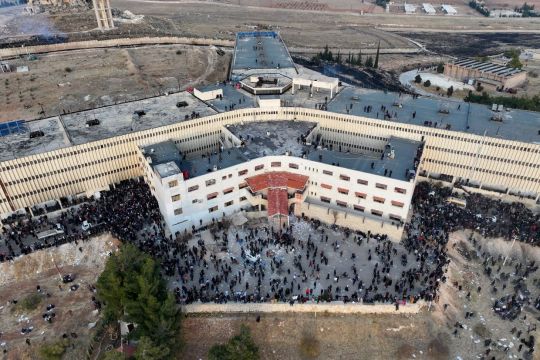
An aerial photo shows people gathering at the Sednaya prison in Damascus, Syria on Dec. 9, 2024, following the fall of the ruling regime. (Omar Haj Kadour / AFP via Getty Images)
One can now enter Bashar al-Assad’s death camp only through Lebanon.
I arrived in the country accompanied by officers from Ukraine’s Defense Intelligence (HUR). They are tasked with evacuating Ukrainian citizens from Syria and simultaneously ensuring my safe passage to Sednaya with the highest possible level of security.
The issue of safety begins in the Beqaa Valley, where we must travel to reach the Syrian border. Like Beirut, the valley is fragmented into various zones of influence but in a more chaotic and informal way. The term “control” here is relative — no one controls anything completely in Beqaa.
The valley is divided between Hezbollah and local gangs involved in arms, drug, and human trafficking. It encompasses both small, ordinary towns and isolated hideouts in the mountains, where various groups take refuge. Additionally, some Russians have partially moved into Beqaa after fleeing Homs, which was the worst piece of news for me amid all the other risks. I was warned about this back when we were in Istanbul, heading here.

Crossing the Beqaa Valley in Lebanon on the way to Sednaya prison in Syria on Dec. 20, 2024. (Stanislav Aseyev)
Having received some guarantees of safety, we reach the Lebanese-Syrian border, where an unusual situation arises regarding our passports.
The issue is that Syria does not currently stamp passports for entry or exit due to the ongoing change of power. This creates a strange scenario: You leave Lebanon seemingly for nowhere and return as if from nowhere, judging by your passport stamps.
Before departing Beirut for the Syrian border, we had conflicting information about who controls the border, including the possibility that it might be entirely unguarded.
However, at the very first checkpoint, we encounter men in military uniforms — members of Hayat Tahrir al-Sham, effectively the new Syrian regime. The second checkpoint is under the same group’s control, though the scene is slightly different: About a dozen armed civilians rush to the vehicle, shouting and gesturing for us to move quickly.

At the Syrian border, entering from Lebanon, on Dec. 20, 2024. (Stanislav Aseyev)

Syrian Border, Syria on Dec. 20, 2024. (Stanislav Aseyev)
Upon entering Syria, the changes in the country become immediately apparent: Syrians have removed or painted over Bashar al-Assad’s portraits wherever possible, replaced the red stripe on the national flag with a green one, and added a star, and just outside Damascus, you come across burned-out tanks and even a destroyed Russian Pantsir air defense system.
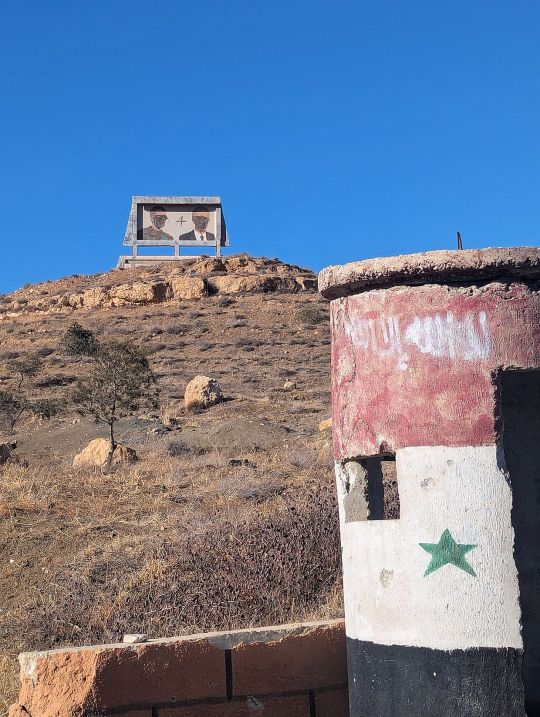


L-C: Defaced portrait of Bashar al-Assad seen in Syria on Dec. 20, 2024. R: Destroyed Russian-made Pantsir air defense system seen in Syria on Dec. 20, 2024. (Stanislav Aseyev)
‘The human slaughterhouse’
In Damascus, we are met by Ali, a representative of the new regime, who has agreed to accompany us to Sednaya. The prison is about a 30-minute drive from the capital.
Even as we approach this concentration camp, its scale is staggering. It resembles a small, enclosed city, surrounded by barbed-wire fences, watchtowers, and, reportedly, a perimeter laden with landmines.
During our visit, the prison caught fire, shrouding its grounds and buildings in acrid smoke.
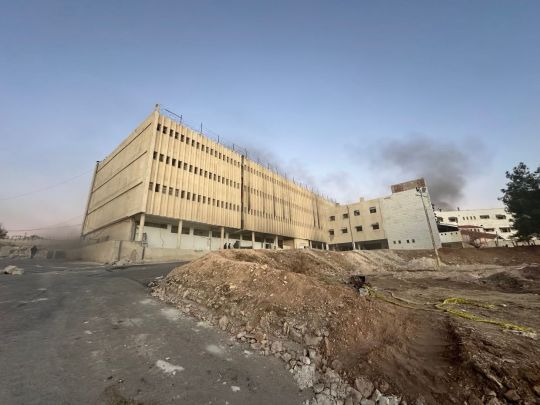
One of the buildings of the Sednaya prison in Syria, seen on Dec. 20, 2024. (Stanislav Aseyev)
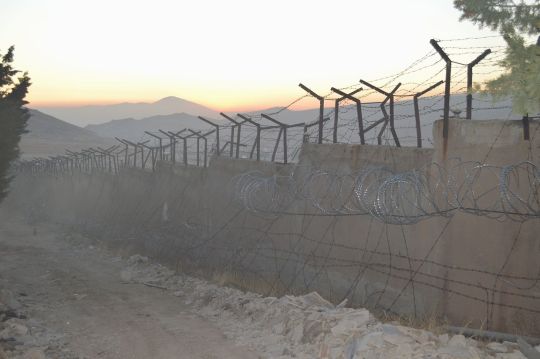
Sednaya, Bashar al-Assad’s Prison, Syria on Dec. 20, 2024. (Stanislav Aseyev)

Sednaya, Bashar al-Assad’s Prison, Syria on Dec. 20, 2024. (Stanislav Aseyev)

Sednaya, Bashar al-Assad’s Prison, Syria on Dec. 20, 2024. (Stanislav Aseyev)
The first thing that catches your eye on the grounds of Sednaya is the haphazardly dug pits surrounding the camp. These are the results of searches for underground prison chambers, where the majority of the inmates were believed to have been held.

The pits dug around the Sednaya prison during the search for underground chambers, seen on Dec. 20, 2024. (Stanislav Aseyev)
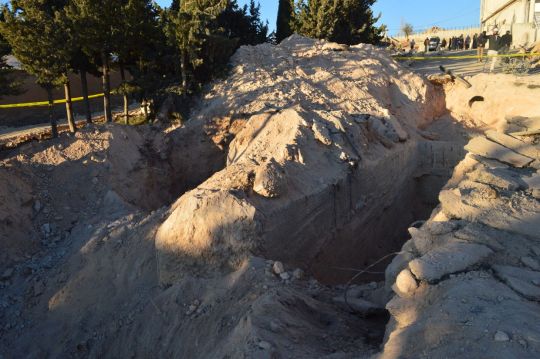
Searching for underground chambers, Sednaya, Syria on Dec. 20, 2024. (Stanislav Aseyev)
Though we arrived in Sednaya late in the day, even at that hour, we encountered a Syrian family walking through the prison grounds, desperately searching for any trace of their relatives who had been detained there.
Every building had already been searched, but such families still hope to find hidden underground chambers whose entrances may have been overlooked.
Relatives post photographs of their loved ones around the grounds — people who disappeared behind the prison’s walls many years ago.
Of everything I witnessed in Sednaya, this was, for me personally, the most haunting sight.
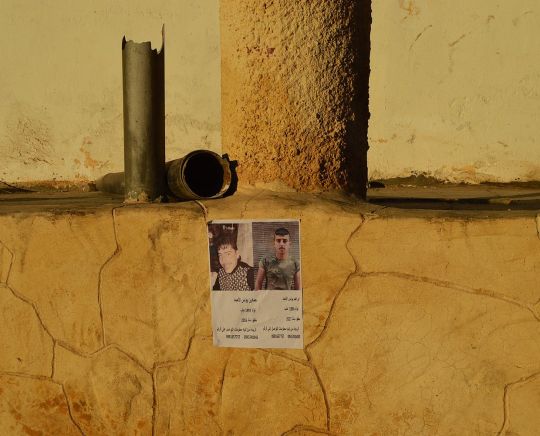
Photos of prisoners sought by their families, posted on the territory of the Sednaya prison in Syria, seen on Dec. 20, 2024. (Stanislav Aseyev)
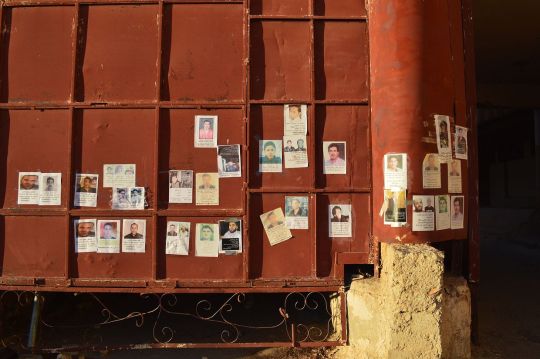
Photos of prisoners sought by their families, Syria on Dec. 20, 2024. (Stanislav Aseyev)
After the prison administration seemingly vanished into thin air, abandoning thousands of inmates in their cells, no one can definitively say how many people were held here — or might still be here.
It is evident that if underground floors exist, no one has provided food or, worse, water to any prisoners there for weeks. This makes the likelihood of finding anyone alive in such chambers slim. The entire site feels like a cemetery, but one that still stirs with faint signs of life.
On our way back, Ukrainian citizens evacuated from Syria by the Ukraine’s Defense Intelligence recounted that in Latakia, nearly everyone has acquaintances or relatives who had been imprisoned during Assad’s regime.
One former prisoner recalled counting 72 stairs when he was led, hooded, up from his cell to another level, and then back.
The use of underground detention practices was prevalent here, much like it is in Russia.
What Russia’s army in Syria stands to lose after fall of Assad
The Kremlin confirmed on Dec. 11 that longtime Syrian dictator Bashar al-Assad had fled to Moscow after rebels took the capital city of Damascus in a lightning offensive that shocked the world. Assad’s exile in Russia comes as little surprise. The Kremlin had invested heavily in propping up the

The Kyiv IndependentKollen Post

Are they still in the dungeons or already executed?
However, the search for underground chambers at Sednaya yielded no results, and by the time of our visit, it had been called off. According to our guide, Ali, the theory of underground facilities is based on information from two sources.

Ali, a representative of the new Syrian regime, and Stanislav Aseyev (R) in Syria on Dec. 20, 2024. (Stanislav Aseyev)
First, some of those released from Sednaya recount being held in windowless rooms for a time before being moved upstairs. Second, according to Syria’s Interior Ministry, the number of prisoners at Sednaya was estimated to be in the tens of thousands, while only about 2,000 have been freed. However, this argument is undermined by the torture and execution chambers at the prison, which had been set up for large-scale operations.
The discovery of a press used for crushing people, the so-called “acid room,” and systematic executions that human rights organizations have documented all these years suggest that the Assad regime has simply killed the missing prisoners.
According to the Syrian Observatory for Human Rights, based in London and monitoring the war in Syria, more than 30,000 prisoners were executed or died from starvation, medical neglect, or torture between 2011 and 2018.

Entrance to Sednaya’s administrative area, Syria on Dec. 20, 2024. (Stanislav Aseyev)

Entrance to Sednaya’s administrative area, Syria on Dec. 20, 2024. (Stanislav Aseyev)

Administrative area of Sednaya, Syria on Dec. 20, 2024. (Stanislav Aseyev)

Cages where prisoners were held before filtration into cells, Sednaya, Syria on Dec. 20, 2024. (Stanislav Aseyev)

Abandoned room of Sednaya’s administration, Syria on Dec. 20, 2024. (Stanislav Aseyev)
The first floor of Sednaya housed administrative facilities such as the kitchen. There was also something resembling a “temporary detention isolation unit,” where those recently brought to the camp were held in cages before being sent to the upper floors.
Above these areas was the prison’s administration’s offices. The administrative staff of Sendaya has fled, all of them.
The upper floors of Sednaya were designated for prisoners: Divided into three blocks, they housed thousands of inmates in nearly bare cells. Ali mentions that in some cells, up to 50 people were crammed in, forcing the prisoners to sleep on their sides, pressed together to fit on the floor. It’s important to note that this took place in a desert environment, with extreme temperature fluctuations: from scorching heat during the day to freezing cold at night.
I’ve heard of such sleeping arrangements from the criminals I met in the Izolyatsiya prison in Donetsk — a similar practice existed in various penal facilities in Ukraine and Russia in the early 1990s. In general, the survival tactics of prisoners often mirror the methods of control over them, so places like Sednaya, Izolyatsiya, or Abu Ghraib share many common elements.

Prison cells in Sednaya, Syria, as seen on Dec. 20, 2024. (Stanislav Aseyev)
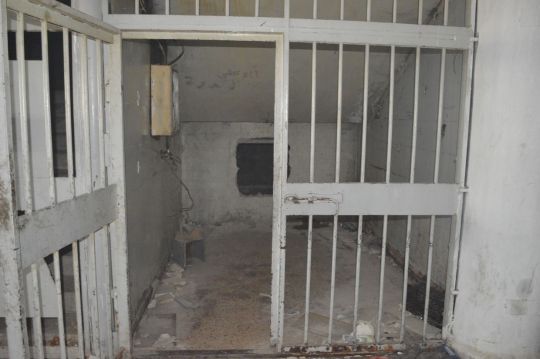
Sednaya prison cells, as seen on Dec. 20, 2024. (Stanislav Aseyev)
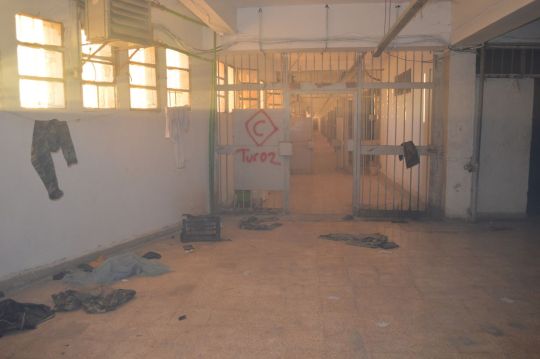
A corridor leading to prison cells in the Sednaya prison in Syria, as seen on Dec. 20, 2024. (Stanislav Aseyev)
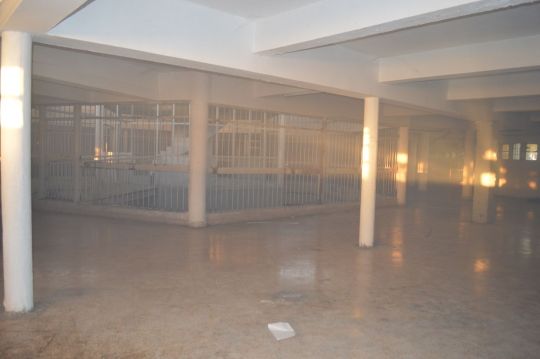
Sednaya corridor, Damascus, Syria on Dec. 20, 2024. (Stanislav Aseyev)

One of the cells, holding around 50 people in Sednaya prison, Damascus, Syria on Dec. 20, 2024. (Stanislav Aseyev)
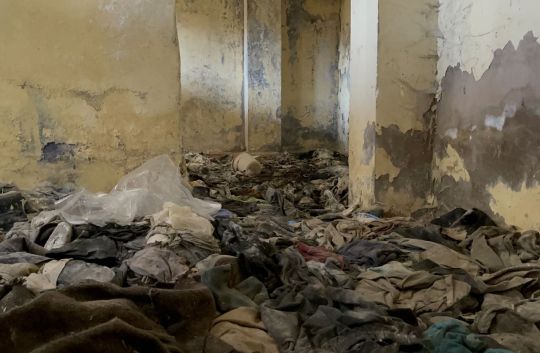
A view from a secret compartment at Sednaya Prison after the fall of the Assad regime in Damascus, Syria on Dec.9, 2024. (Anagha Subhash Nair/Anadolu via Getty Images)
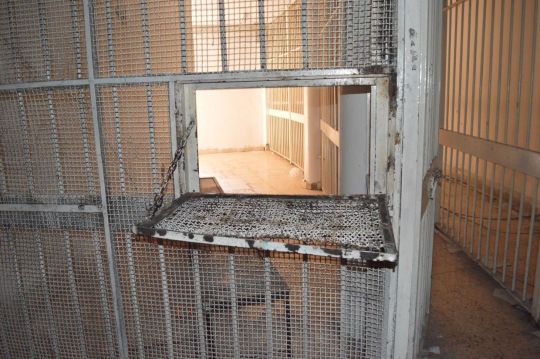
Cell with an open feeding hatch in Sednaya prison, Damascus, Syria on Dec. 20, 2024. (Stanislav Aseyev)

One of the cells, holding around 50 people in Sednaya prison, Damascus, Syria on Dec. 20, 2024. (Stanislav Aseyev)
What reminds about the executions in Sednaya now are the clothes of the condemned prisoners: their bright orange jumpsuits are scattered across the floor, hang from the ropes, and are intentionally placed near the prison building, for journalists to see.

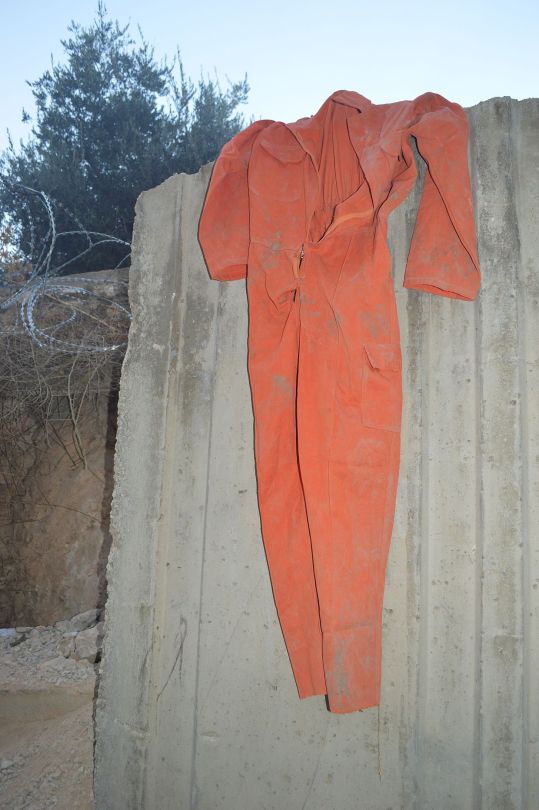
L: Showers in the Sednaya prison in Syria, as seen on Dec. 20, 2024. R: Death row clothing in the Sednaya prison in Syria, as seen on Dec. 20, 2024. (Stanislav Aseyev)
In the final years of its existence, Sednaya became primarily a death camp, where the torture and execution of prisoners were systematic, earning it the grim name of “human slaughterhouse” among locals. Prisoners had their spines broken by special boards, were beaten, raped, starved, and executed, with their remains dissolved in acid.

Death row clothing seen on the floor of the Sednaya prison in Syria on Dec. 20, 2024. (Stanislav Aseyev)

Death row clothing in Sednaya prison, Damascus, Syria on Dec. 20, 2024. (Stanislav Aseyev)
Another eerie parallel with Izolyatsiya emerges: During Assad’s reign, Sednaya instilled such fear among Syrians that its name was often whispered in hushed tones to avoid attracting unwanted attention. This evokes comparisons to the infamous Izolyatsiya prison, where even public transport in Donetsk would avoid stopping near the facility due to the fear it inspired.
Today, Sednaya is a thing of the past.
Now, as with any other abandoned Syrian building, the sun shines through its empty cells, illuminating the walls for the cameras of countless journalists, for whom it is just another job.

Sunset at the Sednaya prison, north of Damascus, Syria on Dec. 20, 2024. (Stanislav Aseyev)
One can hope that the suffering here has ended — but only time will tell whether the Syrian people will truly leave it in the past.
Fall of Assad’s regime disrupts Russian army recruitment in Syria
The collapse of the Bashar al-Assad regime in Syria following a lightning rebel offensive in November has shaken Assad-ally Russia’s near-decade of influence in the country. It has also had one other lesser-known consequence: disrupting Moscow’s ability to recruit Syrian fighters for its war in Ukr…

The Kyiv IndependentKostiantyn Nechyporenko

0 notes
Text
Know All Secrets and Purpose Behind the Hezbollah Bunker
This is why Hezbollah built a bunker under the hospital, a big revelation was made after the recovery of the treasure.

Last month, in September, Hezbollah chief Hassan Nasrallah died in Lebanon's capital Beirut. The bunker in which Hassan Nasrallah was hiding was bombed by Israeli fighter jets. Now, about three weeks after Hassan's death, the Israeli Air Force has released a video. In this video, a treasure is shown in the ground right below a hospital next to Hassan Nasrallah's bunker, which has stunned the whole world. And there is discussion about this treasure everywhere. What is the reality of this treasure? Let's find out. 28 September 2024, 1.30 pm, Dehi - Lebanon
This was the date and time when the Israeli Air Force bombed a special building and a bunker built under the building in the Dahiya area of Beirut, the capital of Lebanon, with its fighter jet. Till now the Israeli Air Force had the news that some people of Hezbollah were present under this building and bunker. But the news that came out from inside the bunker after this shocked the whole world. Actually, Hezbollah chief Hassan Nasrallah also died in this airstrike.
Hassan Nasrallah had never come in front of the world in 18 years
Hassan Nasrallah's death was surprising even for Israel itself. The reason was that Nasrallah had never come in front of the world in the last 18 years. Nasrallah was last seen in public 18 years ago. This was the Nasrallah who had never spent a single night at one place in these 18 years. In such a situation, how did Israel get information about this secret hideout of Hassan Nasrallah? If the news is to be believed, then perhaps the information about Nasrallah's whereabouts was given by none other than the Iranian Kurdish Force Chief Ismail Kani himself. And the news about Kani is that he has been under house arrest in Tehran for the last 3 weeks.
Bunkers were built under the hospital
Israel had dropped bombs in the Dahiya area of Beirut and Hassan Nasrallah died hiding in a bunker there. Actually, this is a residential area of Dahiya. There is a hospital in this area. The name of this hospital is Al-Sahal Hospital. A bunker was built under a part of this hospital. But the path to this bunker does not go through the hospital. There are many houses around the hospital. Among them is a large residential compound consisting of 6 houses. Under the same compound, the Hezbollah chief had built some bunkers. In which he used to hide. One such bunker was also built underground, right under the hospital. But Hassan Nasrallah or his other commanders did not hide in this bunker built under the hospital. Rather, they used this bunker to keep the money that was to be used in the operation against Israel.
500 million dollars and treasure found in the bunker
Israeli Defense Force (IDF) spokesperson Rear Admiral Daniel Hagari made a sensational disclosure while talking to the media. Not only did he make the disclosure but also released a video and some graphics. According to Hagari, Hezbollah had kept about 500 million dollars, i.e. in Indian currency, gold worth about 42 billion and 4 crore rupees and several million dollars in cash in the bunker built right under that hospital.
Hezbollah's financial headquarters was in the bunker!
According to the pictures released by the Israeli Defense Force, Al-Sahal Hospital is in the middle. This hospital has two entry and exit points. There are two buildings in front and behind the hospital. One is Al-Ahmadi Building and on the other side is Center Al-Sahal Building. Bunkers were built under these two buildings and a part of that bunker was right under that hospital. Hezbollah used the same bunker under the hospital to keep its wealth. That is, in a way, it was Hezbollah's financial headquarters.
Dollars and gold were present in half of the bunker
There were many rooms inside this bunker. There were beds in the rooms. That means there was complete arrangement for someone to stay here for a long time. Not only this, this bunker also had all the weapons with which Hezbollah could fight its enemies. Or could retaliate against them. Gold and dollars worth more than half a billion were kept in one part of this bunker. The place where the gold and money were kept is right below the hospital. That means this place was built thoughtfully. Hezbollah was sure that Israel would never bomb the hospital. Therefore, this bunker and the money kept in the bunker will always be safe.
This is how Hezbollah used to get financial help
The question is where did Hezbollah get so much money from? According to the Israeli Defense Force, Hezbollah has two ways of financing itself. First, the Al Qadil Hassan Association in Lebanon helps Hezbollah by collecting donations from Lebanese people or taking a share from working people. Secondly, Iran helps Hezbollah the most financially. According to the IDF, the Iranian Kurdish forces deliver bags full of money and gold to the Iranian embassy in Beirut. This money, which reaches Beirut via plane, is given to Hezbollah.
Hezbollah people also ran factories
According to IDF, apart from these two sources, Hezbollah has another source of income. Hezbollah has set up many factories in Lebanon, Yemen, Syria and Turkey. A part of their income also goes into Hezbollah's account. Hezbollah's Unit 4004 keeps accounts of all these factories.
This treasure will be useful for Lebanon
Now the question is whether the Israeli Defense Force took away the gold and cash worth about half a billion rupees that is inside this bunker built under Al-Sahal Hospital. So according to the IDF, this is not the case. All this money is still present in that bunker under the same hospital. The IDF has said that the Lebanese government, which is struggling with a poor financial condition, can use this money for the welfare of the people. The IDF has also said that it will not target the Al-Sahal Hospital. However, the IDF also clarified that it is constantly monitoring this hospital through satellite. Not only this, as evidence, the IDF also presented pictures of all the activities of the hospital monitored by satellite.
Israel's fight is not with the citizens of Lebanon. However, along with this, the IDF has also threatened Lebanon and international organizations that Hezbollah should not be allowed to use this money. Because they keep an eye on the hospital building all the time. The IDF spokesperson also said that Israel's fight is not with the citizens of Lebanon but with Hezbollah. However, despite this threat from the Israeli Defense Force, it is unlikely that the Lebanese government will be able to use the money kept under the hospital bunker.
Lebanon has two governments!
The biggest reason for this is that the entire area of Dahiya in southern Beirut where this hospital is located is under the control of Hezbollah. Actually, two governments run simultaneously in Lebanon's capital Beirut. One of these is the elected government of Lebanon. Which is headed by Prime Minister Najib Mikati. On the other hand, this area of Dahiya is completely under the control of Hezbollah. Here, the Lebanese government, police or army are not under anyone's control.
Hezbollah's occupation of Maroun al-Ras
The last election in Lebanon was held in May 2022. There are a total of 128 seats in the Lebanese Parliament. But no one got a majority. The post of President of Lebanon is vacant since 2022. The Prime Minister there is also a caretaker. Maroun al-Ras is one of the two parts of Lebanon's capital Beirut. This is the area of Beirut which is occupied not by the Lebanese government but by Hezbollah. And Hezbollah's headquarters is also in this occupied area of Beirut.
Arab countries silent on Israeli attack
The entire area in the bunker where Hezbollah chief Hassan Nasrallah died is also under the control of Hezbollah. The area of Lebanon where the Israeli army is currently fighting a ground war is also under the control of Hezbollah. This is the reason why Arab countries are not speaking openly about the Israeli attack on Lebanon. Because in their view, this attack by Israel is not on Lebanon or the people of Lebanon but on Hezbollah-occupied Lebanon.
Both Lebanon and Gaza are bearing the brunt of today's attack on Israel this year.
#news#free gaza#politics#free palatine#news update#public news#world news#breaking news#gaza strip#israel iran war#israel hamas conflict#israel iran conflict#idf#hezbollah#hezbollah is isis#fuck hezbollah#bunker buster#iran#hamas#houthis#benjamin netanyahu
0 notes
Text
Why the survival of the UNIFIL mission in Lebanon matters for Europe
As US diplomacy seeks last-minute solutions for a ceasefire in Lebanon right before the presidential elections, the Israeli army has increased its pressure against the alleged Hezbollah hideouts in southern Lebanon and Beirut. On Sunday, an IDF bulldozer demolished a watchtower of the UN peacekeeping contingent UNIFIL in Marwahin, triggering the defence ministers of the G7 to express their…
0 notes
Text
Israel unearths Hezbollah's web of tunnels in southern Lebanon
TEL AVIV, Israel (AP) — Israeli forces have spent much of the past year destroying Hamas’ vast underground network in Gaza. They are now focused on dismantling tunnels and other hideouts belonging to Hezbollah militants in southern Lebanon. Scarred by Hamas’ deadly raid into Israel last year that sparked the war in Gaza, Israel says it aims to prevent a similar incursion across its northern…
#General news#hamas#Hezbollah#Hezbollahs#Israel#Israel government#Israel Hamas war#Lebanon#Middle East#Military and defense#Southern#tunnels#unearths#War and unrest#Web#World news
0 notes
Text
TOTAL EMBARRASSMENT TO HEZBOLLAH: The 8th Brigade, under the 91st Division, is taking action in southern Lebanon, crushing Hezbollah Fighters in face-to-face combat and wiping out their weak attempts at resistance along the border. IDF Forces seized piles of outdated Combat gear, including RPGs, Kalashnikovs, and Kornet Missiles, all belonging to the so-called “Radwan Force.” Even their cowardly weapons stashes, hidden inside civilian buildings, were no match for IDF. •Pathetic underground tunnels and hideouts were uncovered, exposing just how desperate and low these Terrorists are, stashing their gear like rats in hiding. •With air support, IDF forces continue to wipe Hezbollah off the map, leaving them scrambling in vain.
Blaze
0 notes
0 notes
Text
हिजबुल्लाह ने इजरायल पर किया बड़ा हमला, हाइफा पर बरसाई 135 मिसाइलें; इजरायल ने 120 ठिकाने किए तबाह
हिजबुल्लाह ने इजरायल पर किया बड़ा हमला, हाइफा पर बरसाई 135 मिसाइलें; इजरायल ने 120 ठिकाने किए तबाह #News
Israel Hezbollah War: इजरायली सेना लेबनान और गाजा में हिजबुल्लाह और हमास के खिलाफ जंग जारी रखे हुए है। कुछ दिन पहले इजरायली सेना ने लेबनान में एक साथ 1600 ठिकानों पर हमला किया और हिजबुल्लाह को कड़ी चोट पहुंचाई थी। सोमवार को हिजबुल्लाह ने सप्ताहभर में इजरायल पर दूसरा बड़ा हमला किया। उसने तीसरे बड़े शहर हाइफा में 135 “फादी 1” मिसाइले दागी। जवाब में इजरायल ने भी लेबनान को दहलाया। हिजबुल्लाह के 120…
0 notes
Text
Israel killed Hezbollah leader Nasrallah with 80 tons of bunker-buster bombs after spies spent years penetrating his entire network
The devastating airstrike that killed Hezbollah leader Hassan Nasrallah was the result of a years-long operation by Israeli intelligence that penetrated the terror leader’s entire network — allowing him to be tracked to his underground command center in Beirut.
The Israeli military used 80 tons of specially designed bunker-busting bombs to blast through the heavily fortified hideout on Friday and kill the slippery Nasrallah — who had survived multiple previous attempts to assassinate him.
Nasrallah’s death was exactly what Israel had been hoping for when it launched a bombing campaign that day, the Financial Times reports.
Unbeknownst to Nasrallah, Israeli intelligence was well aware of the movements of Hezbollah’s leadership following years of hacking and surveillance work on the Lebanese terror group — which is one of the largest and best-armed militias in the world.

10 notes
·
View notes
Text
October 7 - by Joseph Muyuela
Israel. Gaza. Beirut. The West Bank.
Jerusalem was, from its inception, asunder torn.
Israel's Jerusalem east, Palestine's Jerusalem west.
The Holy Land, in truth belonging to the people,
de facto belongs to autarchs and terrorists.
Something blares. In my ears? In the skies, lights glare.
The tea, left to boil in the teapot overnight, has
finally bubbled to the brim, the lid blowing off and
a war coming to all.
Israel counts around 1,200 civilians whose stories are
like candles snuffed.
The perpetrator? Hamas.
251 Israelis' stories are abruptly snatched and taken away,
like a thief perusing a shelf of books in a library and taking
as many books as it could find, taking them back to
his little hideout and defiling the casing, ripping out the
pages and undoing the book bindings.
Israel needs to defend itself, but how?
I know. 41,000 (and counting) dead Palestinians.
Hamas took the lid off the teapot. Hezbollah
smashed the teapot into a million pieces and let all
the chamomile bleed onto the carpet. October 8.
I'd make an analogy for the Houthis, but I
can't think of one.
All of these terrorists organizations are proxies for
another government, a threat so domineering, yet
hiding cowardly behind the people who let the teapot
simmer before shattering it, who hide behind the
thieves that break into the library to steal and defile books.
This is the cost of war, but on a scale unimaginable.
Not just 1 teapot shattered or left to simmer, but millions.
Yet the world, watching in either silence or with an
extremist eye, lets this teapot-shattering, book-defiling war
go on without any measure in place to ensure civilian safety.
All civilians are assumed terrorists, or otherwise brushed
off as the byproduct of war.
Civilians resist terrorists on all sides as the
uninformed hallow terrorism. Children become child
soldiers or are left behind to be swallowed by the ash clouds
and mud giants collapsing upon them. The displaced
clamor for safety in the next humanitarian zone.
The hungry starve. The impoverished are stripped
by both sides of charity.
Always on the precipice of a ceasefire, always on the
verge of a hostage deal, always on the edge of war.
Enlightenment.
Love as an imperative.
Perhaps at the end of the tunnel, there is light.
People come to realizations, find common grievances.
Netanyahu. Hamas. Terrorism. These, we all hate.
Wounds mended, aggravation healed. Perhaps
the end of the tunnel is closer than we think, so much so
'tis not only us reaching out to the light, but the light–
in its elegance and grace–reaching out to us.
I'm sorry. I don't know what to write.
0 notes
Text
BBC 0420 1 Oct 2024
12095Khz 0358 1 OCT 2024 - BBC (UNITED KINGDOM) in ENGLISH from TALATA VOLONONDRY. SINPO = 55434. English, dead carrier s/on @0358z then ID@0359z pips and newsday preview. @0401z World News anchored by Danielle Jalowiecka. § Israel has launched what it has described as "limited, localized, and targeted ground raids" in southern Lebanon, marking an escalation in its continuing offensive against Hezbollah. According to the Israel Defense Forces (IDF) the operation is aimed at the Iran-backed group's "infrastructure" which it says "pose an immediate threat to Israeli communities in northern Israel". Israel's Defence Minister Yoav Gallant earlier implied the army was ready for a ground operation, telling troops near the Lebanese border Israel was prepared to use forces "from the air, sea, and land" to target Hezbollah. § Massive storm Helene has left a trail of devastation across six states in the south-east US, destroying communities and claiming more than 116 lives. The mountainous region of western North Carolina has seen homes and bridges washed away, villages flattened and the tourist city of Asheville cut off. Rescuers are focusing their efforts on reaching those communities on Monday but recovery is proving difficult with so many roads impassable. The death toll is expected to rise as dozens of search teams continue recovery efforts and relatives search for missing loved ones. § At least 24 people were killed by an airstrike on a village in Nigeria's northern Kaduna state, residents and a local councillor said on Monday, after an Air Force operation targeting armed gangs and their hideout. § Three people died and 15 others were injured after a man went on a stabbing rampage inside a Walmart supermarket in Shanghai on Monday night. Chinese police said they arrested a 37-year-old man surnamed Lin at the scene, adding that he had come to Shanghai to "vent his anger due to a personal economic dispute". Further investigations are continuing. § Doctors Without Borders treated more than 25,000 victims of sexual violence in the Congo last year, by far the highest level it has seen there and most of it in the east where armed groups vie for power, the aid group said Monday. § Humberto Ortega Saavedra, the former chief of the armed forces of Nicaragua and younger brother of the current president, who publicly questioned his sibling’s “dictatorial” rule only to wind up under house arrest, died on Monday, the Nicaraguan government announced. He was 77. § Pete Rose, who won two World Series titles with his hometown Cincinnati Reds on his path to breaking the all-time hits record but whose stardom disintegrated after he was caught gambling on his team as manager, leading to his banishment from the game and exclusion from the Hall of Fame, died Sept. 30 in Clark County, Nev. He was 83. @0406z "Newsday" begins. 100' (30m) of Kev-Flex wire feeding "Magic Wand" antenna hanging in backyard tree w/MFJ-1020C active antenna (used as a preamplifier/preselector), JRC NRD-535D, 250kW, beamAz 315°, bearing 63°. Received at Plymouth, MN, United States, 15359KM from transmitter at Talata Volonondry. Local time: 2258.
0 notes
Text
The exact context of this photo is not yet available: False. A reverse image search turns up the news article it came from:
The IDF's latest operation in the northern Gaza Strip continues to expand along with the evacuation of the population from large areas. The forces carry out raids on the compounds of the terrorist organization in Jabaliya, encounters with terrorists and continue cleaning the area. As you may recall, on Friday our military commentator Noam Amir said that the IDF should continue its special operation in the north of the Gaza Strip, move the Gazans from Jabaliya and start slowly building the territory of the north of the Gaza Strip completely free of Gazans. The goal after that is to settle the Gaza Envelope - to return the residents of the Strip back to their homes.
[emphasis mine]
Notably, this was the only news article that showed up in the search for the first two days. There are a few others now, like this from the American Chinese News Network:
Translated:
Although Israeli forces recently eliminated Hamas leader Sinwar, in northern Gaza Hamas has repeatedly rallied in the Jabaniya district, indicating the presence of a vast network of underground tunnels. The Israeli military carried out a large-scale clearing of the area and required all civilians to evacuate, preparing to conduct a thorough attack on the area to ensure regional security. The rout of Hamas marked the group's overall collapse in strategic locations such as the Jabalia district. According to a post by X@Israelwaronhama, the Israeli army will completely destroy this Hamas hideout and end the security threat in the Jabaniya district. The Israel Defense Forces has made significant progress in a series of recent military operations. Hamas' top leader Sinwar was killed by the Israeli military, which immediately triggered a large-scale surrender of Hamas members. It is reported that Hamas's military structure has been severely hit, and some armed forces have voluntarily laid down their weapons in Gaza and surrendered to Israel. The Chinese Communist Party's official media, which has long supported Hamas, still mourned him and issued a statement to pay tribute to Hamas's "heroes" in an attempt to maintain its support for Hamas in international public opinion. However, as Hamas's leadership structure disintegrates, this support appears more isolated. In addition, an IDF spokesman disclosed important intelligence at a press conference, pointing out that Hezbollah has a large amount of gold and banknotes hidden beneath a hospital in Nasrallah's command bunker in Beirut. Israel says it did not destroy the site, but the exposure sparked widespread concern and could make it a target for future Israeli military operations. After Hamas' top leader Sinwar was killed by the Israeli army, Hamas formally surrendered to the Israeli army. And the CCP is still mourning Hamas.
However, multiple journalists have reported seeing or speaking to people who have seen captured civilians being detained by the IOF: True. Multiple journalists have reported that civilians are being detained while they're identified as civilians, rather than Hamas members, and then are released to go to Gaza City.
In at least one instance, outside the Indonesian Hospital, the occupation is believed to have dug a pit forced several captives inside: False. The "pit" described here and shown at the link above is that big dirt patch on the left. You can see a group of people standing around. There's no sign that they were forced inside.
Based on the adults standing in it, the "sides" appear to gently slope down a few feet to the "bottom." This just looks like uneven terrain.

Whether this was for detention purposes, or for something even more sinister, is not yet known: False. The stated purpose is explicitly to separate civilians from combatants, and there are numerous pictures out there from civilians driving to Gaza City, Hamas members who have surrendered, and pictures like the one above, where civilians are just safely standing around.
Nobody has reported any alternative "sinister purposes."
21 October 2024
Journalist Mahmoud Al-Awadia reposts on Telegram a photo recently shared to social media by an IOF soldier in Jabaliya this morning. It appears to show dozens or even hundreds of Gazans crowded together in the street, closely guarded by IOF soldiers. The exact context of this photo is not yet available. However, multiple journalists have reported seeing or speaking to people who have seen captured civilians being detained by the IOF. In at least one instance, outside the Indonesian Hospital, the occupation is believed to have dug a pit forced several captives inside. Whether this was for detention purposes, or for something even more sinister, is not yet known. What is known is the IOF’s pattern of behavior, and it gives us ample reason to be extremely concerned for the captives. Please keep your eyes on Jabaliya and north Gaza.

133 notes
·
View notes